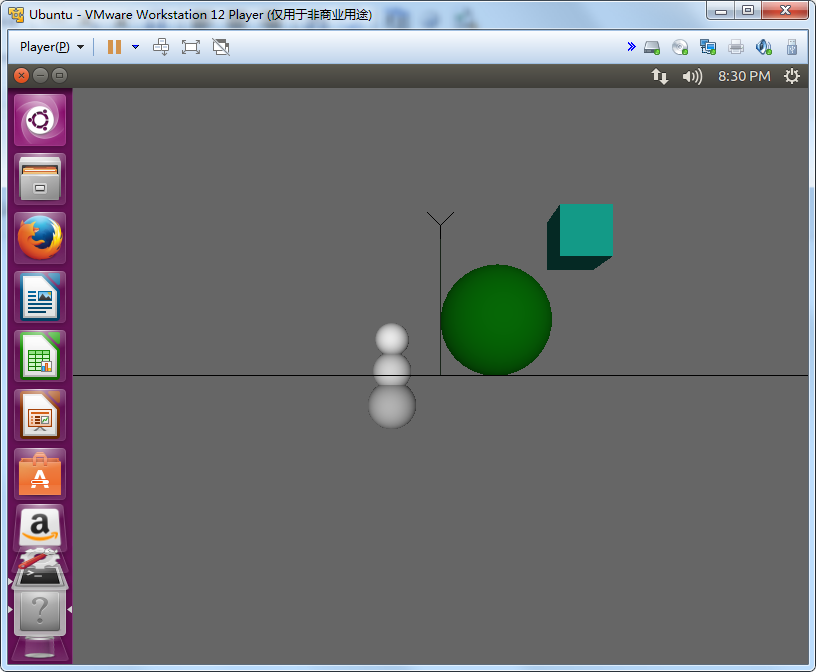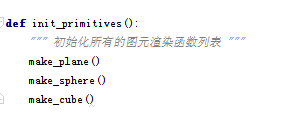首先安装PyOpengl
pip install PyOpenGL PyOpenGL_accelerate
64bit下可能存在glut的问题,解决如下
下载地址:(选择适合自己的版本)http://www.lfd.uci.edu/~gohlke/pythonlibs/#pyopengl
下载下来的whl文件,用pip install file_name.whl进行安装后,问题解决。
在Ubuntu环境下
sudo apt-get install python-opengl
项目效果

程序框架简介:
primitive 负责具体渲染的模型,主要是生成显示列表
G_OBJ_PLANE = 1
G_OBJ_SPHERE = 2
G_OBJ_CUBE = 3

这些模型会在程序初始化的时候运行一次 Viewer的init函数中。
主框架是Viewer文件
MainLoop 里面定时调用这里注册的render函数

render 每次设置好MV矩阵,调用scene里面的render
Scene本身是一个节点的列表。每个节点会调用相应的显示列表来渲染。
代码Viewer.py
# -*- coding: utf8 -*- from OpenGL.GL import glCallList, glClear, glClearColor, glColorMaterial, glCullFace, glDepthFunc, glDisable, glEnable, glFlush, glGetFloatv, glLightfv, glLoadIdentity, glMatrixMode, glMultMatrixf, glPopMatrix, glPushMatrix, glTranslated, glViewport, GL_AMBIENT_AND_DIFFUSE, GL_BACK, GL_CULL_FACE, GL_COLOR_BUFFER_BIT, GL_COLOR_MATERIAL, GL_DEPTH_BUFFER_BIT, GL_DEPTH_TEST, GL_FRONT_AND_BACK, GL_LESS, GL_LIGHT0, GL_LIGHTING, GL_MODELVIEW, GL_MODELVIEW_MATRIX, GL_POSITION, GL_PROJECTION, GL_SPOT_DIRECTION from OpenGL.constants import GLfloat_3, GLfloat_4 from OpenGL.GLU import gluPerspective, gluUnProject from OpenGL.GLUT import glutCreateWindow, glutDisplayFunc, glutGet, glutInit, glutInitDisplayMode, glutInitWindowSize, glutMainLoop, GLUT_SINGLE, GLUT_RGB, GLUT_WINDOW_HEIGHT, GLUT_WINDOW_WIDTH import numpy from numpy.linalg import norm, inv from primitive import init_primitives from Scene import Scene from node import Sphere from node import SnowFigure,Cube,Plane class Viewer(object): def __init__(self): """ Initialize the viewer. """ #初始化接口,创建窗口并注册渲染函数 self.init_interface() #初始化opengl的配置 self.init_opengl() #初始化3d场景 self.init_scene() #初始化交互操作相关的代码 self.init_interaction() init_primitives() def init_interface(self): """ 初始化窗口并注册渲染函数 """ glutInit() glutInitWindowSize(640, 480) glutCreateWindow("3D Modeller") glutInitDisplayMode(GLUT_SINGLE | GLUT_RGB) #注册窗口渲染函数 glutDisplayFunc(self.render) def init_opengl(self): """ 初始化opengl的配置 """ #模型视图矩阵 self.inverseModelView = numpy.identity(4) #模型视图矩阵的逆矩阵 self.modelView = numpy.identity(4) #开启剔除操作效果 glEnable(GL_CULL_FACE) #取消对多边形背面进行渲染的计算(看不到的部分不渲染) glCullFace(GL_BACK) #开启深度测试 glEnable(GL_DEPTH_TEST) #测试是否被遮挡,被遮挡的物体不予渲染 glDepthFunc(GL_LESS) #启用0号光源 glEnable(GL_LIGHT0) #设置光源的位置 glLightfv(GL_LIGHT0, GL_POSITION, GLfloat_4(0, 0, 1, 0)) #设置光源的照射方向 glLightfv(GL_LIGHT0, GL_SPOT_DIRECTION, GLfloat_3(0, 0, -1)) #设置材质颜色 glColorMaterial(GL_FRONT_AND_BACK, GL_AMBIENT_AND_DIFFUSE) glEnable(GL_COLOR_MATERIAL) #设置清屏的颜色 glClearColor(0.4, 0.4, 0.4, 0.0) def init_scene(self): #初始化场景,之后实现 # 创建一个场景实例 self.scene = Scene() # 初始化场景内的对象 self.create_sample_scene() def create_sample_scene(self): # 创建一个球体 sphere_node = Sphere() # 设置球体的颜色 sphere_node.color_index = 2 # 将球体放进场景中,默认在正中央 sphere_node.translate(2, 2, 0) sphere_node.scale(4) self.scene.add_node(sphere_node) # 添加小雪人 hierarchical_node = SnowFigure() hierarchical_node.translate(-2, 0, -2) hierarchical_node.scale(2) self.scene.add_node(hierarchical_node) #添加立方体 cube_node=Cube() cube_node.color_index=5 cube_node.translate(5,5,0) cube_node.scale(1.8) self.scene.add_node(cube_node) #添加Plane plane_node=Plane() plane_node.color_index=2 self.scene.add_node(plane_node) def init_interaction(self): #初始化交互操作相关的代码,之后实现 pass def main_loop(self): #程序主循环开始 glutMainLoop() def render(self): #程序进入主循环后每一次循环调用的渲染函数 # 初始化投影矩阵 self.init_view() # 启动光照 glEnable(GL_LIGHTING) # 清空颜色缓存与深度缓存 glClear(GL_COLOR_BUFFER_BIT | GL_DEPTH_BUFFER_BIT) # 设置模型视图矩阵,目前为止用单位矩阵就行了。 glMatrixMode(GL_MODELVIEW) glPushMatrix() glLoadIdentity() # 渲染场景 self.scene.render() # 每次渲染后复位光照状态 glDisable(GL_LIGHTING) glPopMatrix() # 把数据刷新到显存上 glFlush() def init_view(self): """ 初始化投影矩阵 """ xSize, ySize = glutGet(GLUT_WINDOW_WIDTH), glutGet(GLUT_WINDOW_HEIGHT) #得到屏幕宽高比 aspect_ratio = float(xSize) / float(ySize) #设置投影矩阵 glMatrixMode(GL_PROJECTION) glLoadIdentity() #设置视口,应与窗口重合 glViewport(0, 0, xSize, ySize) #设置透视,摄像机上下视野幅度70度 #视野范围到距离摄像机1000个单位为止。 gluPerspective(70, aspect_ratio, 0.1, 1000.0) #摄像机镜头从原点后退15个单位 glTranslated(0, 0, -15) if __name__ == "__main__": viewer = Viewer() viewer.main_loop()
Scene.py
# -*- coding: utf8 -*- class Scene(object): #放置节点的深度,放置的节点距离摄像机15个单位 PLACE_DEPTH = 15.0 def __init__(self): #场景下的节点队列 self.node_list = list() def add_node(self, node): """ 在场景中加入一个新节点 """ self.node_list.append(node) def render(self): """ 遍历场景下所有节点并渲染 """ for node in self.node_list: node.render()
color.py
# -*- coding: utf8 -*- MAX_COLOR = 9 MIN_COLOR = 0 COLORS = { # RGB Colors 0: (1.0, 1.0, 1.0), 1: (0.05, 0.05, 0.9), 2: (0.05, 0.9, 0.05), 3: (0.9, 0.05, 0.05), 4: (0.9, 0.9, 0.0), 5: (0.1, 0.8, 0.7), 6: (0.7, 0.2, 0.7), 7: (0.7, 0.7, 0.7), 8: (0.4, 0.4, 0.4), 9: (0.0, 0.0, 0.0), }
node.py
# -*- coding: utf8 -*- import random from OpenGL.GL import glCallList, glColor3f, glMaterialfv, glMultMatrixf, glPopMatrix, glPushMatrix, GL_EMISSION, GL_FRONT import numpy import color from primitive import G_OBJ_SPHERE,G_OBJ_CUBE,G_OBJ_PLANE from transform import scaling, translation class Node(object): def __init__(self): #该节点的颜色序号 self.color_index = random.randint(color.MIN_COLOR, color.MAX_COLOR) #该节点的平移矩阵,决定了该节点在场景中的位置 self.translation_matrix = numpy.identity(4) #该节点的缩放矩阵,决定了该节点的大小 self.scaling_matrix = numpy.identity(4) def render(self): """ 渲染节点 """ glPushMatrix() #实现平移 glMultMatrixf(numpy.transpose(self.translation_matrix)) #实现缩放 glMultMatrixf(self.scaling_matrix) cur_color = color.COLORS[self.color_index] #设置颜色 glColor3f(cur_color[0], cur_color[1], cur_color[2]) #渲染对象模型 self.render_self() glPopMatrix() def render_self(self): raise NotImplementedError( "The Abstract Node Class doesn't define 'render_self'") def translate(self, x, y, z): self.translation_matrix = numpy.dot(self.translation_matrix, translation([x, y, z])) def scale(self, s): self.scaling_matrix = numpy.dot(self.scaling_matrix, scaling([s,s,s])) class Primitive(Node): def __init__(self): super(Primitive, self).__init__() self.call_list = None def render_self(self): glCallList(self.call_list) class Sphere(Primitive): """ 球形图元 """ def __init__(self): super(Sphere, self).__init__() self.call_list = G_OBJ_SPHERE class Cube(Primitive): """ 立方体图元 """ def __init__(self): super(Cube, self).__init__() self.call_list = G_OBJ_CUBE class Plane(Primitive): def __init__(self): super(Plane,self).__init__() self.call_list=G_OBJ_PLANE class HierarchicalNode(Node): def __init__(self): super(HierarchicalNode, self).__init__() self.child_nodes = [] def render_self(self): for child in self.child_nodes: child.render() class SnowFigure(HierarchicalNode): def __init__(self): super(SnowFigure, self).__init__() self.child_nodes = [Sphere(), Sphere(), Sphere()] self.child_nodes[0].translate(0, -0.6, 0) self.child_nodes[1].translate(0, 0.1, 0) self.child_nodes[1].scale(0.8) self.child_nodes[2].translate(0, 0.75, 0) self.child_nodes[2].scale(0.7) for child_node in self.child_nodes: child_node.color_index = color.MIN_COLOR
transform.py
# -*- coding: utf8 -*- import numpy def translation(displacement): """ 生成平移矩阵 """ t = numpy.identity(4) t[0, 3] = displacement[0] t[1, 3] = displacement[1] t[2, 3] = displacement[2] return t def scaling(scale): """ 生成缩放矩阵 """ s = numpy.identity(4) s[0, 0] = scale[0] s[1, 1] = scale[1] s[2, 2] = scale[2] s[3, 3] = 1 return s
primitive.py
# -*- coding: utf8 -*- from OpenGL.GL import glBegin, glColor3f, glEnd, glEndList, glLineWidth, glNewList, glNormal3f, glVertex3f, GL_COMPILE, GL_LINES, GL_QUADS from OpenGL.GLU import gluDeleteQuadric, gluNewQuadric, gluSphere G_OBJ_PLANE = 1 G_OBJ_SPHERE = 2 G_OBJ_CUBE = 3 def make_plane(): glNewList(G_OBJ_PLANE, GL_COMPILE) glBegin(GL_LINES) glColor3f(0, 0, 0) for i in xrange(41): glVertex3f(-10.0 + 0.5 * i, 0, -10) glVertex3f(-10.0 + 0.5 * i, 0, 10) glVertex3f(-10.0, 0, -10 + 0.5 * i) glVertex3f(10.0, 0, -10 + 0.5 * i) # Axes glEnd() glLineWidth(5) glBegin(GL_LINES) glColor3f(0.5, 0.7, 0.5) glVertex3f(0.0, 0.0, 0.0) glVertex3f(5, 0.0, 0.0) glEnd() glBegin(GL_LINES) glColor3f(0.5, 0.7, 0.5) glVertex3f(0.0, 0.0, 0.0) glVertex3f(0.0, 5, 0.0) glEnd() glBegin(GL_LINES) glColor3f(0.5, 0.7, 0.5) glVertex3f(0.0, 0.0, 0.0) glVertex3f(0.0, 0.0, 5) glEnd() # Draw the Y. glBegin(GL_LINES) glColor3f(0.0, 0.0, 0.0) glVertex3f(0.0, 5.0, 0.0) glVertex3f(0.0, 5.5, 0.0) glVertex3f(0.0, 5.5, 0.0) glVertex3f(-0.5, 6.0, 0.0) glVertex3f(0.0, 5.5, 0.0) glVertex3f(0.5, 6.0, 0.0) # Draw the Z. glVertex3f(-0.5, 0.0, 5.0) glVertex3f(0.5, 0.0, 5.0) glVertex3f(0.5, 0.0, 5.0) glVertex3f(-0.5, 0.0, 6.0) glVertex3f(-0.5, 0.0, 6.0) glVertex3f(0.5, 0.0, 6.0) # Draw the X. glVertex3f(5.0, 0.0, 0.5) glVertex3f(6.0, 0.0, -0.5) glVertex3f(5.0, 0.0, -0.5) glVertex3f(6.0, 0.0, 0.5) glEnd() glLineWidth(1) glEndList() def make_sphere(): """ 创建球形的渲染函数列表 """ glNewList(G_OBJ_SPHERE, GL_COMPILE) quad = gluNewQuadric() gluSphere(quad, 0.5, 30, 30) gluDeleteQuadric(quad) glEndList() def make_cube(): glNewList(G_OBJ_CUBE, GL_COMPILE) vertices = [((-0.5, -0.5, -0.5), (-0.5, -0.5, 0.5), (-0.5, 0.5, 0.5), (-0.5, 0.5, -0.5)), ((-0.5, -0.5, -0.5), (-0.5, 0.5, -0.5), (0.5, 0.5, -0.5), (0.5, -0.5, -0.5)), ((0.5, -0.5, -0.5), (0.5, 0.5, -0.5), (0.5, 0.5, 0.5), (0.5, -0.5, 0.5)), ((-0.5, -0.5, 0.5), (0.5, -0.5, 0.5), (0.5, 0.5, 0.5), (-0.5, 0.5, 0.5)), ((-0.5, -0.5, 0.5), (-0.5, -0.5, -0.5), (0.5, -0.5, -0.5), (0.5, -0.5, 0.5)), ((-0.5, 0.5, -0.5), (-0.5, 0.5, 0.5), (0.5, 0.5, 0.5), (0.5, 0.5, -0.5))] normals = [(-1.0, 0.0, 0.0), (0.0, 0.0, -1.0), (1.0, 0.0, 0.0), (0.0, 0.0, 1.0), (0.0, -1.0, 0.0), (0.0, 1.0, 0.0)] glBegin(GL_QUADS) for i in xrange(6): glNormal3f(normals[i][0], normals[i][1], normals[i][2]) for j in xrange(4): glVertex3f(vertices[i][j][0], vertices[i][j][1], vertices[i][j][2]) glEnd() glEndList() def init_primitives(): """ 初始化所有的图元渲染函数列表 """ make_plane() make_sphere() make_cube()